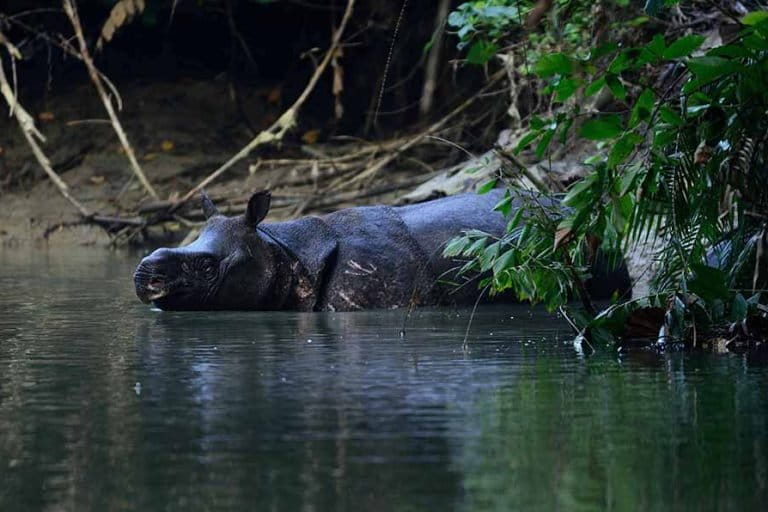- A tsunami that killed more than 400 people in Indonesia has left the last remaining population of Javan rhinos unscathed.
- The species’ last habitat, Ujung Kulon National Park, was hit by the Dec. 22 tsunami caused by an eruption of the Anak Krakatau volcano, but the rhinos were not in harm’s way, officials have confirmed.
- The disaster has once again highlighted the constant peril that the species lives under, and strengthened calls to establish a new habitat elsewhere to ensure the survival of the rhino.
JAKARTA — A devastating tsunami that killed more than 400 people in Indonesia has left the last surviving population of Javan rhinos unscathed — but has highlighted once again the dire threats facing the critically endangered species.
The Dec. 22 tsunami, caused by a landslide in the Sunda Strait following a massive eruption of the Anak Krakatau volcano, struck the western tip of Java and southern end of Sumatra. The confirmed death toll as of Dec. 27 was 429, with 154 people missing and feared dead.
The volcano, a remnant of the legendary 1883 Krakatau eruption, is also within sight of Ujung Kulon National Park in Java, home to the world’s last Javan rhinos (Rhinoceros sondaicus). The tsunami generated waves up to 5 meters (16 feet) high, some of which crashed ashore Ujung Kulon, killing two park agency officers and damaging office posts.
All of the rhinos, however, are believed to be safe, said Mamat Rahmat, the park chief. He said the animals tended to cluster along the southern coast of Ujung Kulon, sheltered from the impact of the waves coming from the northwest. The latest estimate of the park’s Javan rhinos puts the population at a minimum of 68 individuals.
Ridwan Setiawan, national rhino officer at WWF-Indonesia, said a joint team had been deployed to assess any damage, including checking camera traps installed near the coast.
Like Mamat, he said few rhinos were found in the affected northern stretch of the park, and credited the hilly terrain, peaking at an elevation of 500 meters (1,640 feet), with keeping the park’s wildlife safe from the waves.
“The area is pretty high. I think wildlife have a natural instinct to save themselves by going to a high ground,” Ridwan said.

Anak Krakatau has erupted hundreds of times in recent months, and has continued to do so since the Dec. 22 eruption that sheared off part of the southwestern flank of the volcano. Experts believe the collapse of the flank into the sea was what set off the tsunami. A series of eruptions from Dec. 26 have generated huge plumes of ash that have drifted over the land.
The Indonesian Meteorology, Climatology and Geophysics Agency (BMKG) on Dec. 27 raised the alert for the volcano to the second-highest level on its four-point scale, indicating an escalation in volcanic activity and the increased possibility of a major eruption. Authorities have declared a 5-kilometer (3-mile) exclusion radius around the volcano.
Conservationists have long warned about the continuing threat of natural disaster to the Javan rhino, and have advocated for establishing a new population in a second site, to ensure the survival of the species.
“Noting how dangerous the area is, it’s best that the second habitat be immediately prepared, as has been planned for so long,” Sunarto, a wildlife expert at WWF-Indonesia, told Mongabay.

Javan rhinos are known to prefer low-elevation forests, but finding a suitable habitat safe from the threat of natural disaster could prove difficult: Indonesia is also home to the most active volcanoes in the world, and this year alone has suffered three major earthquakes and two deadly tsunamis.
“I hope there won’t be another big tsunami like the one in 1883,” Mamat said, referring to the deadly waves up to 46 meters (151 feet) high that, together with the hot ash and gases from the Krakatau eruption, killed more than 36,000 people.
Locations being considered as a prospective new home for the Javan rhino include Cikeusik and Cikepuh, both near Ujung Kulon, in the province of Banten. However, Cikeusik lies in Pandeglang district, which was hit hardest by the recent tsunami.
Cikepuh, seen by most experts as the more viable option, is on the southern coast of Java and wasn’t affected by the tsunami. But there are bureaucratic obstacles to dedicating the area to rhino conservation, including its current designation as a military site and the local government’s plans to make it an ecotourism park.
Some conservationists have called for the new habitat to be outside land-scarce and densely populated Java, but among officials that seems to be the most politically difficult proposition.
In addition to natural disasters such as volcanic eruptions and tsunamis, the Javan rhino is threatened by diseases that can be transmitted by domestic livestock and native wild cattle living in and near Ujung Kulon.
The rhino was once found throughout Southeast Asia, but since the poaching of the last member of its mainland subspecies in Vietnam in 2009, its last surviving population is confined to Ujung Kulon, a protected zone spanning a total 1,230 square kilometers (475 square miles).
“Considering the current situation, we need to maximize our conservation efforts,” Ridwan said. “The threats [to the rhinos] from natural disasters are rising.”

The story was reported by Mongabay’s Indonesia team and was first published on our Indonesian site on Dec. 25, 2018.
FEEDBACK: Use this form to send a message to the author of this post. If you want to post a public comment, you can do that at the bottom of the page.